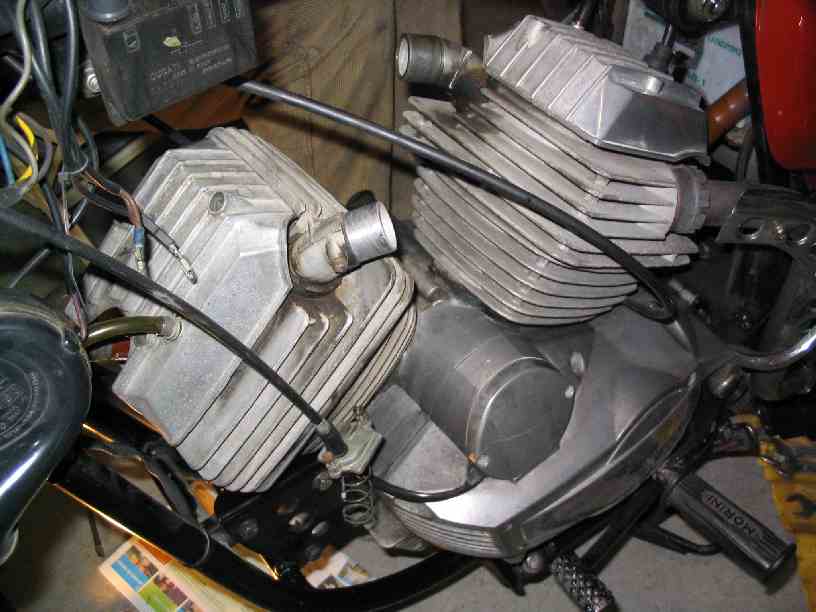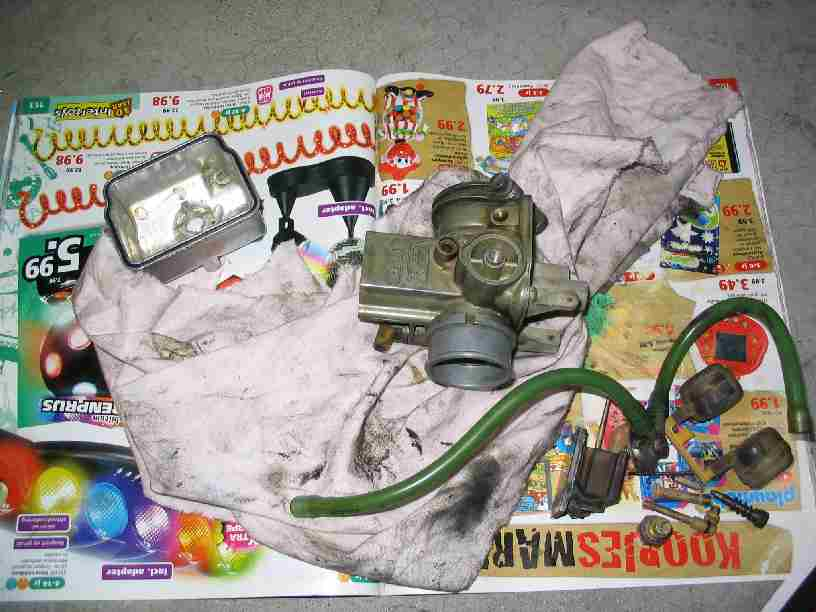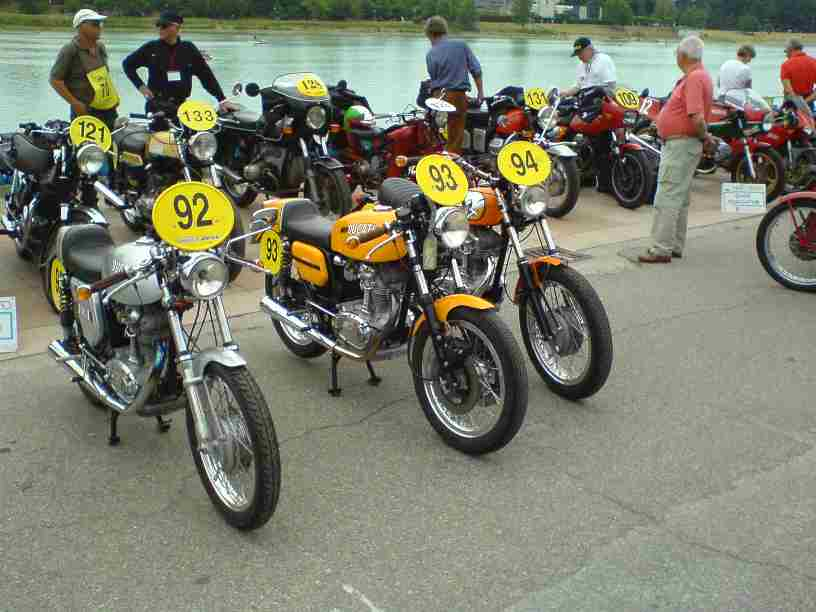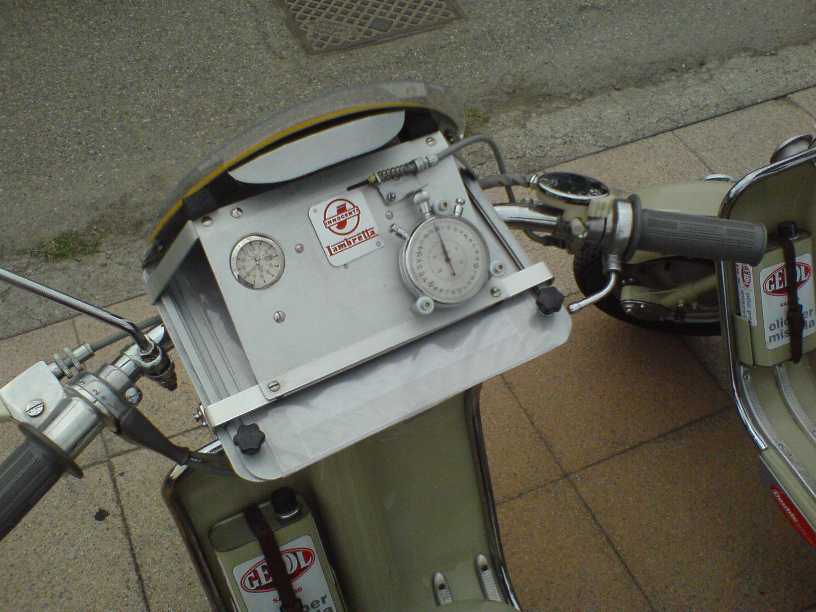Participation to the Milano - Taranto motorrally in Italy, July 2007
(you can click on most pictures for full size)
 |
Introduction
In 2004/5, I decided to take part in a fabulous trip to the number one motorcycle country: ITALY.
I became a member
of the Dutch Aermacchi Club, as they offer excellent facilities for
their members, such as transport of the motorbikes from the Netherlands to Italy and back again. The Aermacchi Club states
as a condition that the (Italian) classic bike to ride Milan-Taranto on should have a drum brake at the front wheel. No problem
for my 34-year-old Moto Morini 3 1/2 Touring. The Aermacchi Club also arranges membership for the participants of Moto Club
Veteran 'San Martino', the organisers of Milan-Taranto.
First some history on Milano-Taranto
Between 1919 and 1925 the Milano-Napoli race was held under the name of 'Raid Nord-Sud'. In 1932, the race was extended to Taranto. Rome was also
added to the route as an important 'pit stop'. From the same year the name was changed to 'Coppa Mussolini'. It is difficult to
imagine that the race took place
on public roads. From 1936 onwards besides 'normal' racers, more and more Grand-Prix racers were used, like the Moto Guzzi
Bicilindrica or the Gilera with a compressor. These bikes had external batteries for lights! Difficult to imagine that at night,
speeds of over 170km/h (106mph) were reached. The racing motorcyclists shared the roads with normal traffic. At railway crossings
it was compulsory to stop. The fastest riders covered the distance of app. 1,400km's
(875 miles) in about 14 hours. Racing motorcyclists on bikes with smaller engines took much more time. They also started at night. They would see the night change into day and again into night. These smaller machines were less reliable and suffered from often
brake downs. For the Italian motorcycle industry, the Milano-Taranto race was very important. In 1953 Laverda gained the first 14
places at the finish in the 75cc class. Because of this their sales went up incredibly. The 1,300 to 1,400km's were covered nearly non-stop. The few stops during the race were kept as short as possible to only refuel and eat. The 2nd World War stopped the race
between 1940 and 1950. The race started again in 1951. More traffic and the much higher speeds of the racing bikes as a result
there were three fatalities in 1955. |
This bike I registered for participation:
a 1973 Moto Morini 3½ Touring |
 |
In 1956 the last Milano-Taranto road race was organized. In the end, the
event had taken place 16 times.
In 1955 Francisci Bruno was victorious on a Gilera 500/4 in time of 11 hours, 5 minutes and 25 seconds.
An incredible average speed of 126,234km/u (79mph).
Milano-Taranto now
In 1986 the Italians brought Milano - Taranto back to life again. But now the riders take 6 days/stages to cover
the distance. On average 300-350km’s a day on secondary roads. These days, the trip is more like a rally. It is not
a competition for the fastest riders, but it is important to start at the right on time from the stops. Leaving late means penalty
points in the list of rankings. To achieve this, you have to ride keeping this in mind and also have to keep your
bike in top condition. Fortunately, my 34-year-old Morini did not falter. Total distance which I covered in Italy was 2,105km.
|
 |
Mario Preta reed de ruim 1.400km in 1955 op een Moto Morini Rebello 175cc in
12 uur. Gemiddelde snelheid boven de 115km/u |
|
 |
Full service before the rally
Two weeks before leaving for Italy, together with a friend we carried out the following maintenance to my bike.
- Changed 3 litres of motoroil (20W50) and washed out the oil filter.
- Replaced the cam belt.
- Took off the carburettors and cleaned them out. Replaced the needle valves;
- Synchronised the carburettors with use of a mercury column.
- Adjusted the valve clearance.
- Set the chain tension & lubricated the chain.
- Replaced the battery, more as a precaution, because the old battery was 6 years old. Nice detail: a Morini 350 will start
and run normally, even with a flat battery.
- Replace the petrol lines.
- Check and adjust the brakes.
|
 |
A few pictures of the full service, before I left for Italy.
 |
 |
 |
replacing the cam belt |
took off the carburettors |
carburettor and jets/atomisers (bottom rhs) |
|

The route from Milan in the North to
Taranto in the South. Over 2,100km's. |
On Saturday the 1st of July, the bikes had to be taken to a garage near Amsterdam. From there a truck would take the bikes
to Milan. At the garage I got a good look at the bikes of the other participants: Aermacchi AlaVerde (250cc/1962), MV Augusta
(350cc/1974), four (!) Condors (350cc/1976/7). These Condors (ex Swiss Army of Belgian military police) all have a tuned-down
Ducati single desmo engine. Furthermore there were two Aermacchi-Harley Davidson SS-350 motorbikes from 1973 and 1975. Two
BSA's: 650 and 500cc from 1954 and 1956. Some participants would bring their bike to Italy in a van or on a trailer. In Milan
Dutch riders with the following bikes joined the group: 2x Aermacchi TV 350 (1972), Moto Morini 350 Sport (1976), Aermacchi
Rickman Metisse (1972), 2x Aermacchi SS 350 (1971/3), Moto Guzzi GT 2VT 500cc (1931), Moto Guzzi 500cc Falcone Sport (1959),
Moto Guzzi Condor 500cc (1939), Moto Guzzi Falcone Sport 500cc (1955). Gilera Rosa extra 175cc (1958), Moto Guzzi Lodola
175cc (1957). Also 2 bikes with sidecars: a BMW R50 (1962) and a Guzzi Falcone (1953). Last but not least: Jelle and Matilde
took part in a Messerschmitt "cyclecar.” With this mini-car, driver and passenger are seated behind each other. At the front
there are two wheels, at the back one. The engine is a 2-stroke 191cc Sachs with 9hp. These mini-cars were popular at the end
of the 50s, early 60s. A second, Italian team had a (Czech made) Velorex (350cc Jawa engine). In this vehicle, driver and passenger
are seated next to each other. Two wheels at the front, one at the rear. The rear of this vehicle is a motorbike, covered with metal
tubes and cloth.
 |
 |
 |
83&84 Condors, 123: oldest
participant a Guzzi GT 2VT
from 1931! |
56: Gilera Rosa. My own
Morini without the starting
number |
BSA's 500cc & 650cc |
|
 |
On Saturday, the 7th of July, I took the train to Eindhoven for a (cheap) flight with Ryanair to Bergamo
near Milan. In Eindhoven, I met with a group of Dutch participants. Fortunately, the flight was just over an hour, as the
seats in the plane were tightly packed together. After arrival, a taxi van was waiting for us and took us to our hotel
near Milan. In the evening most of us had dinner in the hotel. On Sunday, we did not do much. But I still had to fix the
yellow plates with my start number (82) on the bike. I had some cable ties. But needed some small pieces of aluminium that
were found in the hotel car park did the trick.
Up to Milan!
On Sunday afternoon at about 16.00h we rode in a column for less than 20 minutes to Milano. East of town, near the airport
Linate, there is a lake with a rowing corse, the
Lago Idroscalo.
|
Briefing in the hotel. left-to-
right: Lex (first class
mechanic), Teus, Riet, Annet,
Theo, Jos (standing),
Cees,
Joop, Henk. |
The bikes were parked according to the engine size. It gave a nice overview of the total international entrants. Participants
from (of course) Italy, Germany, Switzerland, and the Netherlands. One participant & passenger with their 1934 Gilera with
sidecar came from Monte Carlo. First we had to sign in with the officials from the organisation. We then received a bag with
information, a smock with our start number and a special pass for the hotels and dinners. Next our bikes were inspected.
Luckily for some, this was rather relaxed, because some ancient bikes had trouble producing light front and rear.
 |
 |
 |
Registration with the ladies of the organisation |
Teus on his 350cc MV Augusta
(1974) at the inspection |
|

these arrows indicated our route
through Italy |
The numbers of entrants were as follows:
- 3 participants in the 75cc class,
- 2 participants in the 100cc class,
- 2 teams in cycle cars, the Messerschmitt and the Velorex,
- 8 teams motorbikes with sidecar,
- 19 participants on scooters, Vespas and Lambrettas,
- 4 participants in the 125cc class,
- 10 people in the 175cc class,
- 11 people in 250cc class,
- 21 riders with a 350cc,
- 47 persons with a bike of 500cc or more,
- Finally 3 teams in the "gastronomically" class and 19 individual riders.
|
 |
Before, I had asked my friend Paolo (a true Morinisti!!) to meet me at the start and it was very
nice to meet him and his wife in the middle of this two-wheel event. |
Back to the categories: the gastronomically group does not ride for the list of rankings, so they can arrive and leave the
in-between stops when they feel like, but to win this class, all participants had to be weighed. The person who would gain
the most weight, after arrival in Taranto would win the class. This gave us a good idea of what was in front of us: the
Italians would treat us to their finest dishes and best specialities during the days to come....
An impression of the bikes of the participants
 |
 |
 |
On the left, the lighter bikes
and scooters, in the
background the rowing corse |
Two Ducati's Desmo 350cc
from 1972/4 and a '73
Scrambler |
Brothers in arms:
79: Aermacchi SS 350 (1971)
owned by Nel;
87: Aermacchi Harley Davidson
350cc (1973) of Janette;
82: my own 1973 Moto Morini 3½
Touring |
|
 |
 |
 |
 |
77: the Morini of Roel and left
of it Kees' blue Aermacchi 350.
In the foreground the yellow
Aermacchi Rickman Metisse
owned by Marc |
Zündapp "Grüner Elefant"
(Green Elephant, officially
KS 601S (597cc) from 1954 |
2: a Moto Guzzi Motoleggera
from '53 with a capacity of
65cc |
51: a 1957 175cc Moto Morini
Super Sport |
 |
 |
 |
 |
nicely prepared Lambretta's
(148cc from 1955/6) owned
by father & daughter |
the dash of the Lambretta's,
stopwatch activated by a
lever on the handlebars and a
small clock |
heavier bikes |
101&102, Moto Guzzi Falcone
from 1950/1 |
 |
 |
Through the arrow to  page 2 page 2 |
123: the oldest participating bike dating from 1931.
It is a Moto Guzzi GT 2VT,
a factory long-distance-racer.
Only 3 were ever produced. Wim told me that the factory
gave him a thick folder with
documentation on this bike,
including a sheet with the history - and victories - of this
rare motorbike. Wim made
it to the finish in Taranto on his
Guzzi GT 2VT!!! Excellent achievement!! |
|
|

